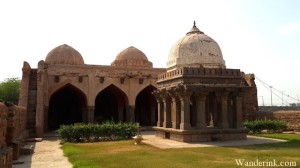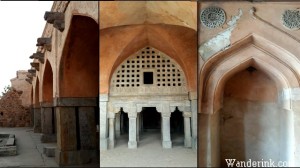“There is a temple in the centre, around it is a mosque,” said Chotu (‘helper’) pointing through the spiny shrubs that separated the palisaded ASI monument and the reclaimed bog where the workshop stood. Once he was sure he had my undivided attention he went on to assure me that there was ‘firing and killing and burning’ between Hindus and Muslims. But that was way before he came from Bihar, eight years ago, as a 10-year-old on the wallaby track. “Since then they have kept it under lock and key to avoid any further trouble.” Under lock and key it was, I found out later. But not for the frenzied reasons cited.
“I need some water,” I told Chotu. My Bullet clutch had burnt in the intense traffic and heat along the bridge connecting East and North Delhi and new ones had to be brought from Karol Bagh. The Ustad (‘chief’) had gone to get them personally leaving unequivocal instructions that the Saab (‘boss’ in this case, me) was to be looked after ‘like a VIP.’ The wait was going to be long. A charpoy was laid out and dusted with a black, oil-dried scrap. I was told to lie down and relax; it didn’t matter that the cantankerous, cacophonous traffic that fried my plates was within expectorate distance.
Chotu brought me shikanji, the Indian summer favourite, from the freshly prepared lot of ‘Modinagar Ki Mashoor, 36 masala-wali’ pushcart, painted in bright red and yellow. The mechanic and the shikanji kitchen shared backend space with that of a cushion and pillow shop. The shikanji guy peered at me for feedback – he was about to wheel out his wares for that afternoon. There was no way I could find where the water came from. But the crushed ice and the pungent salts were an instant thirst quencher, I nodded my approval.
People began to arrive in groups of twos and threes with vessels containing coloured rice and stews. They sat around and ate, smoked beedis and left. Another group took turns gulping down what looked like consommé from a grubby pot. A newly arrived hobo and his woman sat on their haunches with their meagre possessions strewn around. Whatever could be spared was shared. In return the woman washed the dishes. Nothing was required or said. They left after some, unnoticed, just the way they came. Most who sat down for lunch invited me to join in; I took a roti and dipped into watery dal curries or picked on sautéed bhindi. The Ustad was known for his bike-mending skills all over the ilaka, locality, everyone informed me by way of pleasantry.
An orange-bearded guy took out a piece of sponge from his pink kaftan and placed it under his head before lying down for a post prandial snooze. He was soon joined by a little boy who wound his spindly legs around the man’s waist. Both were slumbering soon.
Chotu attended to customers in the Ustad’s absence including a young girl who stormed in and blustered out her Scooty had ‘stopped working.’ Experienced mechanics usually know from the tone of whine the nature of the complaint. “During summer it is usually problems associated with overheating,” Chotu said. They tinker for a bit allowing the engine to cool off and the bike is good to go. Chotu charged fifty rupees from the girl who told him it was her lunch money; he settled for twenty.
By late afternoon Ustad still hadn’t turned up and I was joined by a real estate agent from the neighbourhood. We discussed the new generation and procreation over beedis.
“Is everything alright with you?” He asked me when I informed him I was childless. “Have you seen a doctor?”
I gave him my usual spiel on the world we leave behind, rising crime, climate change and the capital region running out of water in the next decade. He thought for a long minute and asked:
“Are you gay?”
Satan at bay
The tomb of Shah Alam or ‘Wazirabad tomb’ shone like a bone under the boiling sun. Piqued equally by the dramatic narrative of Chotu earlier that day I walked to the gates that opened to the site lawn, clasped together by a chain. What he pointed out as a temple did not look like one from the distance. But there had to be some reason behind such a vehement tale of religious fervour and ferocity. The tomb complex was bolted.
“Why is the site locked?” I asked the mali, gardener, appointed by the ASI, who was in no mood to budge from the cool shade where he sat.
“Sir, with so many colleges around kids come here and do all sorts of shaitani,” he replied leaning back to take me in better.
“Sir, as you can see I am alone and thus cannot be up to any shaitani,” I pointed out.
He still refused to move – probably it was onanism he was up against. I had to remind him none too gently that whatever the reason he had no right to arbitrarily declare the monument out of bounds to anybody. Prodded by the wiser suffragan-gardener he reluctantly parted with the Key to Erebor and I found myself surrounded by splendour from seven centuries ago.
The main structure of the Shah Alam Tomb is a three-domed mosque with five arches and two main prayer chambers. Alongside the main prayer chamber there is a smaller area raised on pillars and covered with stone jaali, latticework screen. This was for women worshippers. The mausoleum itself, built by Feroz Shah Tughlaq for Saint Shah Alam in the 14th century, is in the centre of the courtyard and faces the mosque. It is placed on a raised square platform surrounded by a dozen stout stone pillars supporting a multi-tiered dome. A stencil-perfect ornate floral design, dyes still intact, is engraved on to the convexity at the top. A smaller, single-domed structure is across the tomb with cooler, darker interiors; I could feel the mali’s eyes on me when I entered this space. A flight of steep stone stairs led up the main mosque from where you could see the still-in-use Wazirabad Bridge of the same age.
Ustad called. He was back from Karol Bagh. My bike was almost ready. I sprang down the steps, told the mali that I’d be back to check whether he still locked up the site.
“But sir…shaitani…”
I bounded into the workshop next door. An auburn haired, buxom woman draped in gilt-edged dupatta and nylon churidhar was leaning over the burial mounds of pirs scattered around. A photographer with a telephoto lens was shouting instructions from atop a house next to it barely larger than a larder. She was soon joined by a well-muscled male who slipped a casual arm around her ample waist and together they began pouting for the camera.
Dusk-born phantasms, perhaps. It was time to go.
















What finds one finds when not looking…
…and learns when not seeking.
No doubt India is a vast diverse and full of religious and natural beauties. You captivate the readers by your unique writing skills. I really enjoyed,but i like if you add more pics. 🙂
I believe a pix in itself is a 1000 words…so more pix might make my posts unwieldy. But thank you for the feedback.
Amazing blog and beautiful post I love it
Thank you. Very much.